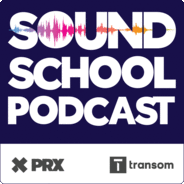On this episode, the convention-busting production choices of "10 Things That Scare Me."

FeatureLeben & Liebe
Sound School Podcast Folgen
The Backstory to Great Audio Storytelling, hosted by Rob Rosenthal, for Transom and PRX.
Folgen von Sound School Podcast
341 Folgen
-
Folge vom 30.04.2019Eight Things I Like About 10 Things That Scare Me
-
Folge vom 16.04.2019NuggetsSometimes, there's just too much good work to feature on HowSound. To solve the problem, from time to time I feature a slew of ear-catching clips on one episode. On this episode, work from Believed, 99% Invisible, This American Life, and Threshold.
-
Folge vom 02.04.2019How Sruthi TracksAt a school where I taught radio, in the mic booth, there was a photo of Studs Terkel hanging on the wall. Under it, someone wrote “Talk to Studs.” The picture was there to help with tracking. Narration will sound more conversational if you pretend you’re talking to Studs, the thinking went. After all, that’s the goal, right? To track like you’re just talking to someone. Hanging up a picture and talking to it may be a good (and slightly weird) first step toward tracking naturally, Sruthi Pinnemaneniof Reply Alltakes things a whole lot further because she’s driven to avoid sounding like she’s reading something written. She very much wants listeners to fall into a story because her voice sounds unaffected and genuine. “(At Reply All) we try to track in a way that is closer to ‘I’m telling a story to somebody,'” she says. “When we’re tracking, we almost always have a producer or someone in the room where we’re trying to recreate that feeling of ‘I’m here and I’m feeling the excitement and joy that I know exists in this story.'” She says it’s not just a matter of talking to that person in the room. They help, too. They offer feedback, of course. But, they also play tape. Sruthi listens to a quote in her story then, right as it finishes, she narrates. “The tape always carries a certain kind of emotion,” she explained to me. “Either you’re surprised by what the person is saying or what the person is saying makes you laugh. And so you want the tracking, the line that you’re saying out of it, to carry that emotion.” What else does she do? Sruthi lays it out in this episode of HowSound.
-
Folge vom 19.03.2019An Editor’s FingerprintsSince 2009, Julia Barton's edited a lot of radio and podcasts you probably listen to including Revisionist History. On this HowSound, Julia talks shop about her approach to editing.
